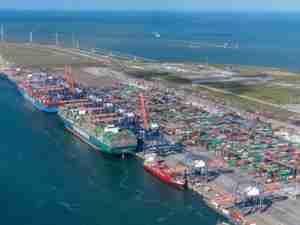It will be the port’s second Liebherr mobile harbor crane and will match the first one, which the port bought in 2006. That crane is capable of lifting 140 metric tons, making it the largest mobile harbor crane in North America. The second crane will have the same capacity.
The Liebherr LHM 500S – capable of lifting the equivalent of an adult blue whale – will be built in Rostock, Germany and delivered by Star Shipping directly to the Port of Vancouver, with the voyage beginning in January 2009. It will be assembled at the port, and commissioned shortly thereafter.
Commissioners on May 27, 2008, authorized port staff to solicit bids for a second mobile harbor crane, and on September 23, authorized staff to use a sole source solicitation to assure that the port gets the crane that most appropriately fits its specific needs.
This crane will give the port twin cranes that will be used for lifting wind energy cargo and other heavy project cargos.
As wind energy cargo and project cargo increases significantly in the next year and the long term, the port will need the crane in order to keep up with the amount of cargo moving across its docks.
“We also expect to be loading more wind energy cargo to rail, which means we need another heavy-lift crane to efficiently move cargo across the port,” Paulson said. “In other words, we’ll be able simultaneously unload vessels with one crane while loading cargo to trucks or rail cars. Additionally, some wind components require two cranes in order to eliminate the possibility of damage. These heavy capacity cranes can also safely handle other large, heavy components without turning the vessel – an important cost saving feature.”
The port also expects to be using some of the Alcoa/Evergreen property for storage of the wind energy components, which means that at times, a second crane will be needed at that location to place the components that come off a vessel into storage before they’re due to be delivered to the job site, while another crane offloads cargo from the ship.
With the second crane, the port will not only be able to continue to attract more wind energy business, but also more of the heavy-lift project cargo. By having two cranes that are the same, the port would be able to use the two cranes in tandem to increase the total lifting capacity to at least 210 metric tons.
“Thanks to having the first crane, Longshore crews working at the Port of Vancouver in 2007 put in 72,000 work hours on wind energy components alone, and the ILWU (International Longshore & Warehouse Union) local hired 26 new full-time Longshore workers due to the wind energy cargo increase,” said Operations Manager Mike Schiller.
Like the port’s first LHM 500S, the new crane will have the capability to lift greater weights on an extended boom, and then rotate up to 360 degrees to position the cargo on the dock. These features improve the efficiency of cargo operations and minimize multiple moves; ultimately, saving port customers time and labor costs.
With 20 axles and 80 wheels the LHM 500S crane can maneuver in any direction, and can be positioned along the port’s marine terminals, cargo storage areas, or rail yards. The crane weighs more than 500 tons, has a tower height of 116.5 feet, and a boom length of 174 feet.










